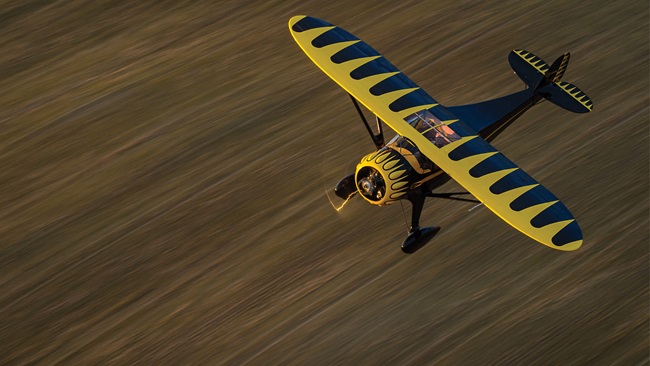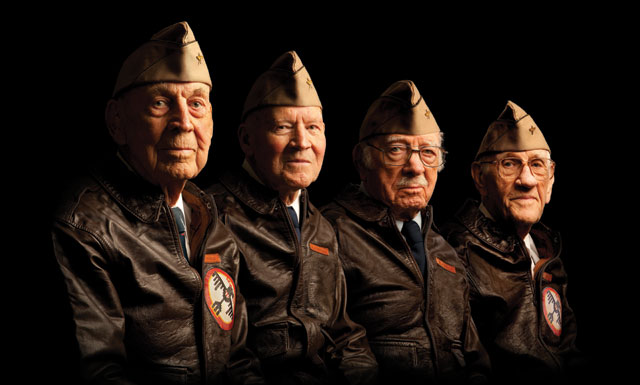
Reunited for the seventieth anniversary of the Doolittle Tokyo Raid are (left to right) Lt. Col. Richard E. Cole, Staff Sargeant David G. Thatcher, Lt. Col. Edward J. Saylor, and Major Thomas G. Griffin.
Photography by Robert Seale and Mike Fizer
In loose formation, 20 North American B–25 Mitchells fly a low pass over the National Museum of the U.S. Air Force in Dayton, Ohio. Four men dressed in matching navy blue blazers with yellow crests grin widely as the bombers rumble overhead in clear skies, light winds, and mild temperatures. It was a far different setting 70 years earlier when those same men, along with 76 others, faced deteriorating weather conditions while flying 16 B–25Bs from the USS Hornet in the Pacific Ocean to bomb Tokyo. On April 18, 1942, the Tokyo Raiders launched early because the carrier had been spotted by the enemy. They didn’t know if they would have enough fuel to land safely in China. After bombing their targets in Japan, they neared China in the dark in rain and reduced visibility. One crew landed in the Soviet Union; the others bailed out over China or ditched off the Chinese coast. Three Raiders were executed by the Japanese, one died in prison, and four remained prisoners of war; two other Raiders died after their aircraft were ditched. The rest survived with help from the Chinese, and many returned to continue fighting in World War II.
“Our purpose was to give the folks at home the first good news that we’d had in World War II,” the Air Force museum quoted James H. “Jimmy” Doolittle, who led the raid as a lieutenant colonel and was promoted to brigadier general after its success. “It caused the Japanese to question their warlords. And from a tactical point of view, it caused the retention of aircraft in Japan for defense of the home islands when we had no intention of hitting them again, seriously in the near future.” After news spread of the Tokyo Raiders’ successful strike against Japan’s mainland, morale in the United States soared. “The Doolittle Raid was the first domino in the series” of the Pacific campaign, said Larry Kelley, owner of the B–25 Panchito, who helped organize a mass gathering of the bombers in Dayton, working with the Air Force to gain permission for 20 of the warbirds to land on a closed runway near the museum for the seventieth anniversary of the raid.
Yet the men who pulled off what seemed impossible simply say they were just doing their jobs, following the plan, and carrying out what they were trained to do—nothing special. “The Raiders don’t like to be singled out,” said retired Lt. Col. Richard E. Cole during a ceremony commemorating the day, honoring those who lost their lives because of the mission, and paying tribute to the Raiders who have since died. Only five Raiders are living; four, including 97-year-old Cole, attended the anniversary celebration. Retired Lt. Col. Robert L. Hite, who served as a co-pilot on Crew No. 16 and was one of the four to survive as a prisoner of war in Japan, was not able to attend.
Lt. Col. Richard E. Cole, co-pilot Crew No. 1
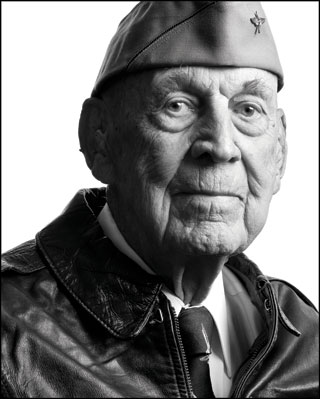 Perched on the USS Hornet, the B–25 Mitchell’s radial engines developing max power, Doolittle and Cole, his co-pilot, held the brakes, deployed full flaps, and prepared to lead 15 other bombers on a daunting mission: the Tokyo Raid.
Perched on the USS Hornet, the B–25 Mitchell’s radial engines developing max power, Doolittle and Cole, his co-pilot, held the brakes, deployed full flaps, and prepared to lead 15 other bombers on a daunting mission: the Tokyo Raid.
The crews had trained for this day, albeit on dry ground at Eglin Field in Florida. Navy pilot Lt. Henry L. Miller was called in to “teach us how to make short-field takeoffs,” said Cole, who retired from the military as a lieutenant colonel in 1967. They practiced with a 10-knot headwind and the same load they would carry the day of the mission.
“We were able to get off in 500 feet,” Cole said. According to the Air Force museum, during training one B–25 lifted off in just 287 feet. The pilots were supposed to receive 50 hours of training, “but I don’t think we made more than 30 [hours]. Time was of the essence.”
When the men learned the details of the mission for the first time on the USS Hornet, they were jubilant, Cole recalls; then “a little bit later when things got quiet,” they pondered the implications associated with the assignment. Still, he said, “nobody jumped ship.”
The pilot Cole was originally scheduled to fly with became ill, so Doolittle stepped in. “I was a very lucky guy,” he recalled of flying with Doolittle. Eight hours ahead of schedule, 650 miles out to sea, they departed. A 25- to 30-knot wind from the carrier and the “same amount from Mother Nature” aided the short-field takeoff performance, as well as a deck officer who timed the bomber’s takeoff run so that the “carrier would drop down and kind of throw the airplane up in the air,” Cole explained. Even with the challenging task that lay ahead, “I never had a bad feeling. I think you waste time thinking of bad things.”
Cole’s military career led him to take part in another secret mission, flying Douglas C–47s with the First Air Commando Group towing gliders at night over Japanese-occupied territory later in World War II. Today, his operations aren’t secret; now, he likes to fly “opp” (other people’s planes) when he gets the chance.
Maj. Thomas C. Griffin, navigator Crew No. 9
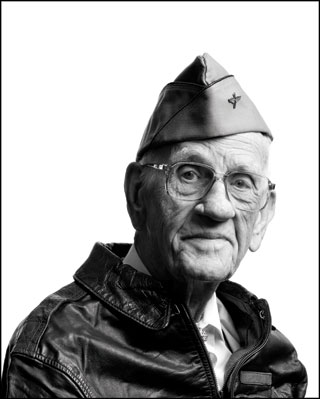
Thomas C. Griffin’s task was no easy feat—setting a course to Japan from 650 miles away. “On this particular mission, it was more or less dead reckoning,” the navigator recalled of using wind information and a magnetic compass.
Because they had to take off farther out to sea than planned, Griffin’s calculations showed his aircraft would have to ditch 200 to 300 miles from the coast of China after bombing Japan. Their plan, he said, was to ditch next to the first ship they saw. “It’s just a matter of being able to change your immediate plans,” the 95-year-old said—almost as nonchalantly as deciding to change dinner plans—of the call to depart early. Aircraft No. 9 bombed the Tokyo Gas and Electric Co. After bombing Japan, “we got some big breaks in the weather,” he said. The aircraft flew south until out of sight from the Japanese mainland and then turned west toward China; a strong tailwind south of Japan carried them into China where they bailed out.
Although Griffin returned to the United States a few months after the Tokyo Raid, he would serve in World War II as a crew member on a B–26 in North Africa. He was forced to bail out on one assignment, and crashed on another. Griffin spent most of the final two years of World War II as a prisoner of war in Germany. “I did the best I could and was fortunate to still be alive when the war ended,” he recalled. “It was a tough way to spend 22 months in a prison camp there. It saved my life in one way.”
Staff Sgt. David J. Thatcher, engineer-gunner, Crew No. 7
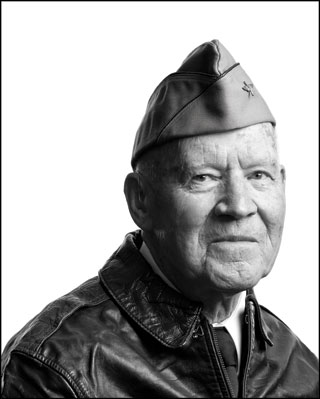 When engineer-gunner David J. Thatcher regained consciousness, the B–25 was inverted in water; he escaped through a hatch. “When I got out of the airplane, it was about waist deep,” he said. Thatcher’s four crew members were seriously injured from being thrown from the bomber on impact.
When engineer-gunner David J. Thatcher regained consciousness, the B–25 was inverted in water; he escaped through a hatch. “When I got out of the airplane, it was about waist deep,” he said. Thatcher’s four crew members were seriously injured from being thrown from the bomber on impact.
He had signed up for the secret mission because it was “something to do during the war.” Hours before the accident, manning his post in the top turret of the B–25B, Thatcher kept a “sharp lookout for them and any other aircraft that may be in the vicinity” as the bomber flew just 50 feet above the water to avoid detection. They flew low until just before reaching their targets and pulled up to prevent blast fragments from their own bombs from hitting the aircraft. After dropping their one-ton load, Thatcher said the crew’s immediate thought was, “We had to get out of there.”
The aircraft pressed on toward China but ran low on fuel before reaching the mainland. It was dark and raining. The crew spotted a stretch of beach through a hole in the clouds and decided to land, but the B–25 touched down short—in the water with its landing gear extended—and “turned us over.” All but Thatcher were unable to walk the next morning. The crew was still in Japanese-occupied territory; friendly Chinese helped the men to evade the enemy for two days to make it into free territory. Then, it took another day to get to a hospital, Thatcher said. He later received a Silver Star for helping the crew survive.
Thatcher, now 91, went on to serve as an engineer-gunner on a B–26 in North Africa and was discharged from the military in July 1945 after his last assignment in California, just before the war ended.
Lt. Col. Edward J. Saylor, engineer Crew No. 15
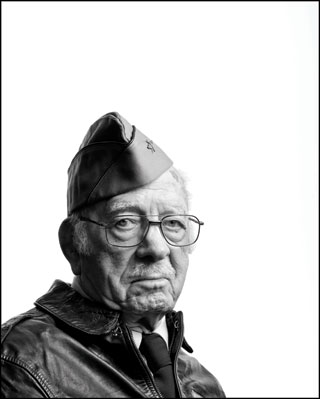 At 22 years of age, Edward J. Saylor found himself in a foreign country, hiding from an enemy, trying to make it back to friendly territory. Chinese civilians helped Saylor and the rest of the crew in Aircraft No. 15 get through eastern China to a point where U.S. aircraft could land. During those couple of weeks, Saylor said, they rarely met anyone who could speak English, yet they all worked together to survive. Because of the help the Chinese civilians gave to the crews that ditched near or bailed out over China, the Japanese retaliated by killing an estimated 250,000 Chinese.
At 22 years of age, Edward J. Saylor found himself in a foreign country, hiding from an enemy, trying to make it back to friendly territory. Chinese civilians helped Saylor and the rest of the crew in Aircraft No. 15 get through eastern China to a point where U.S. aircraft could land. During those couple of weeks, Saylor said, they rarely met anyone who could speak English, yet they all worked together to survive. Because of the help the Chinese civilians gave to the crews that ditched near or bailed out over China, the Japanese retaliated by killing an estimated 250,000 Chinese.
During the seventieth reunion in Dayton, Saylor and the other Raiders met Chinese families of those who had helped the crews in 1942, celebrating, perhaps the only time representatives from all elements of the Tokyo Raid could be in one location: the Raiders, USS Hornet crew, Chinese citizens who helped the men, and B–25s.
Saylor, an engineer, made it back to the United States by the end of June, just in time to be home for the Fourth of July. He continued to serve in the military and spent two years with the Royal Air Force as a technical officer during a project to introduce a new fighter into the air force. He retired from the military in 1967.
“It was a hard mission, but we got away with it,” said Saylor, now 92, reflecting on the operation. “We always knew it would help morale.”
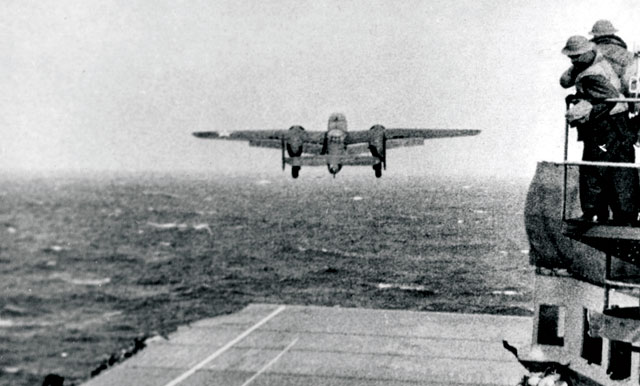
The B-25s were the first American bombers to take off from an aircraft carrier.
Loud and lucky
Pilots discount discomforts to fly B–25
Vibrations from Panchito’s 1,700-horsepower Wright R-2600 radial engines rattle the bare metal North American B–25J Mitchell. The crew’s comfort wasn’t high on the list of priorities when designing the craft—no interior insulation, thin padding on the seats, sharp metal edges, and tiny crawl spaces. “It was made to drop bombs and shoot guns,” said Paul Nuwer, one of Panchito’s pilots, who has 1,200 hours flying restored B–25s. With an empty weight slightly more than 21,000 pounds and a maximum takeoff weight of 41,800 pounds, the medium-range bomber has plenty of fuel- and munitions-carrying capacity and a cavernous bomb bay.
The two roaring engines produce a deafening sound (even when using headsets) and vibrate every fiber of the body, seemingly syncing a passenger’s heartbeat to the propellers. It gives new meaning to becoming one with the aircraft. With their senses heightened, the crewmembers are keenly aware that they are flying a piece of history, one that played a key role during World War II. Among the B–25’s most notable accomplishments was the successful Tokyo Raid led by then-Lt. Col. James H. “Jimmy” Doolittle, even though 15 of the 16 aircraft were destroyed; one aircraft landed in the Soviet Union but the others crashed when their crews bailed out over China or ditched off the coast after running low on fuel.
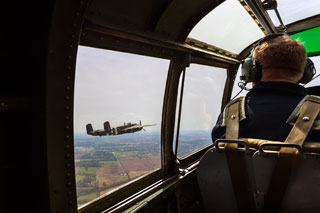
Twenty B–25s from around the country gathered in Ohio earlier this year, to present a flying tribute commemorating the seventieth anniversary of the Tokyo Raid. The B-25 crews offered rides, shared stories, and honored the five remaining Raiders at the event.
The crews were also aware that they operate 70-year-old aircraft. Ground crews were at the ready with fire extinguishers in hand while signaling for engine start. A fire would be catastrophic for these old engines that guzzle fuel and oil by the gallon.
While the Tokyo Raiders had to take off from the USS Hornet in less than 500 feet, those who fly the aircraft seven decades later prefer to have at least 3,500 feet to take off and 4,500 feet to land so that they don’t wear the brakes. Former Doolittle co-pilot Richard E. Cole attributed his and Doolittle’s short takeoff distance to a “double whammy” that B–25 pilots don’t have today. The USS Hornet’s forward speed gave Cole and Doolittle a 25- to 30-knot headwind, and the aircraft carrier turned to take advantage of a strong headwind from Mother Nature.
As one of the first nosewheel aircraft developed, the B–25 is tricky to control on the ground. “It’s a tailwheel airplane with a nosewheel,” said Nuwer. A free-castering nosewheel and touchy brakes mean some differential power must be used to maneuver the aircraft that some call a “nosedragger.” “You have to think a lot ahead of it,” Nuwer said, adding, “It’s like driving a dump truck without power steering.” Sometimes, the pilot may be turning left while applying full right rudder.
Despite the ground-handling characteristics, the aircraft is agile and responsive yet forgiving in the air, designed for a young pilot with only a couple hundred hours to take to war. Jim Gower, who graduated from the Army Air Corps cadet program, learned to fly the B–25, stepping up from a 65-horsepower Piper Cub to a 220-horsepower Stearman to a 650-horsepower North American AT–6. Although the war ended before Gower could be deployed overseas, he flew the B–25 over Texas and New Mexico.
Like other World War II B–25 pilots still living, Gower is matter of fact about flying the bomber: “I never had any trouble, you just use your brakes,” he said of taxiing the aircraft.
The only downside to the aircraft—one that Cole, Gower, and the crews that fly the restored pieces of history agree upon—is the noise. Some crews use hand signals to communicate checklist items, even when wearing high-end headsets.
When Gower and Cole were flying, headset technology didn’t compare to what is available today. “We were all young, so it didn’t matter,” Gower said of the noise, “as long as we could fly.” —AJM



